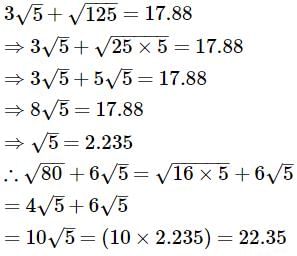Bank Exams Exam > Bank Exams Tests > Test: Square Root And Cube Root- 1 - Bank Exams MCQ
Test: Square Root And Cube Root- 1 - Bank Exams MCQ
Test Description
10 Questions MCQ Test - Test: Square Root And Cube Root- 1
Test: Square Root And Cube Root- 1 for Bank Exams 2025 is part of Bank Exams preparation. The Test: Square Root And Cube Root- 1 questions and answers have been prepared
according to the Bank Exams exam syllabus.The Test: Square Root And Cube Root- 1 MCQs are made for Bank Exams 2025 Exam.
Find important definitions, questions, notes, meanings, examples, exercises, MCQs and online tests for Test: Square Root And Cube Root- 1 below.
Solutions of Test: Square Root And Cube Root- 1 questions in English are available as part of our course for Bank Exams & Test: Square Root And Cube Root- 1 solutions in
Hindi for Bank Exams course.
Download more important topics, notes, lectures and mock test series for Bank Exams Exam by signing up for free. Attempt Test: Square Root And Cube Root- 1 | 10 questions in 10 minutes | Mock test for Bank Exams preparation | Free important questions MCQ to study for Bank Exams Exam | Download free PDF with solutions
Detailed Solution for Test: Square Root And Cube Root- 1 - Question 1
Detailed Solution for Test: Square Root And Cube Root- 1 - Question 2
Test: Square Root And Cube Root- 1 - Question 3
If 3√5 + √125 = 17.88, then what will be the value of √80 + 6√5?
Detailed Solution for Test: Square Root And Cube Root- 1 - Question 3
Detailed Solution for Test: Square Root And Cube Root- 1 - Question 4
Detailed Solution for Test: Square Root And Cube Root- 1 - Question 5
Detailed Solution for Test: Square Root And Cube Root- 1 - Question 6
Detailed Solution for Test: Square Root And Cube Root- 1 - Question 7
Detailed Solution for Test: Square Root And Cube Root- 1 - Question 8
Detailed Solution for Test: Square Root And Cube Root- 1 - Question 9
Test: Square Root And Cube Root- 1 - Question 10
If the product of three consecutive positive integers is 15600 then the sum of the squares of these integers is
Detailed Solution for Test: Square Root And Cube Root- 1 - Question 10
Information about Test: Square Root And Cube Root- 1 Page
In this test you can find the Exam questions for Test: Square Root And Cube Root- 1 solved & explained in the simplest way possible.
Besides giving Questions and answers for Test: Square Root And Cube Root- 1, EduRev gives you an ample number of Online tests for practice
Download as PDF




















